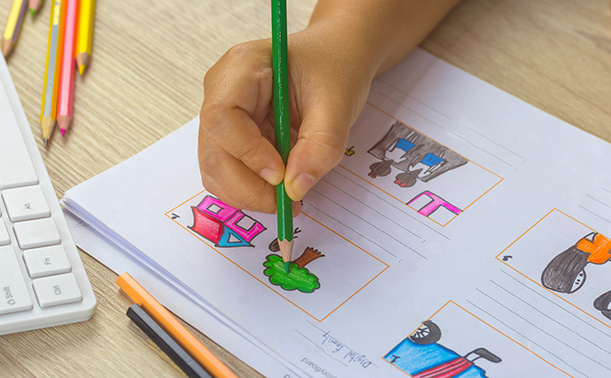BOOMbox at Home: Animation Activities
September 22, 2020

Animation is made by creating a sequence of drawings or posed puppets, with each image slightly different from the next. When shown one after the other, they create the illusion of movement. Let's look at activities that help us understand how animation works.
Making a Flip Book Animation
Flip book animation is a great way to get started with animation. A flip book is a book with drawings on each page that create movement when you flip quickly through it, usually by running your thumb along the pages. Flip books are made from small-sized paper, and are usually not thicker than a few inches, which makes it easier to flip easily and smoothly through the pages. A pad of sticky notes or a stack of note cards cut in half make great bases for a flip book. If your stack is not bound together, you can clip them together with a binder clip.
You don’t need to have special drawing skills to make a flip book. Animator Andy Bailey shows the flip books he made for fun as a kid. They use basic shapes, faces, and stick figures to tell moving stories. A great first project is to draw a bouncing ball. This Introduction to Animation Khan Academy course, made in collaboration with Pixar animator Rob Jensen, teaches the basic principles behind animation through animating a bouncing ball. It also provides interesting insights into the mathematical principles behind 2D and 3D animation.
Pre-Film Animation Illusions
Although the form of animated movies we are familiar with today did not develop until the end of the early 1900s, throughout the 1800s, people were experimenting with toys and devices that created the illusion of moving pictures. Examples of these are zoetropes and phenakistoscopes, which both use spinning motion in order to show images one after the next.
To build a phenakistoscope, you need paper (thick paper works best), a pin or dowel to secure the disks, and a stick to use as a handle (a pencil works well). This tutorial on how to make phenakistoscopes comes with a PDF of animation disks that you can print and assemble. To use a phenakistoscope, stand in front of a mirror, and spin it while looking through the slots in the disk. Your view is momentarily blocked between drawings, making our brain fill in the gaps between frames and creating the illusion of movement. You can also draw your own animations. Watch a video tutorial that shows the process of drawing and building a phenakistoscope, or check out this video of a 3D zoetrope! It uses sculptures instead of drawing, and the same animation principles as the phenakistoscope, like spinning movement, to make the characters move.
Comic Book Panels
Animation allows creators to tell a story through a moving visual medium, fueling our imaginations and bringing characters to life. Many series draw their inspiration from comics, with story lines adapted from its source material. Manga is one popular version of comics that originated in Japan, and many have turned into anime shows, movies, and films. The Marvel and DC universe comics provide another example of comics being turned into cartoons and eventually full-length movie adaptations.
Creating comics is as easy or as difficult as you choose to make it, since the story line and the characters are all up to you. All you need to get started is a paper and a pencil, or if you prefer, you can use free printable comic book templates. With hundreds of template designs to choose from, you can easily bring your imagination to life.
For a detailed videos on how to make comics, check out Dave McDonald’s Kids Make Comics series, a seven-part series designed for kids ages 7 and up. It teaches you all the basics that come along with comic book making, including how to draw characters, speech bubbles and action boxes.
Stop-Motion Animation
Stop-motion animation is another form of animation in which a bunch of pictures are put together in rapid succession to make an object appear to move fluidly. Mashable created a video that explains what stop-motion is and how the old technique is still used today, with the movies Coraline and Corpse Bride used as popular examples.
To get started with stop-motion animation, see this Tinkerlab tutorial, which goes through all the materials you need, from the backdrop to the objects you plan on animating. Tinkerlab recommends using a stop-motion app to help with the process, such as the free version of Stop Motion Studio by Cateater available for iOS and Android.
Another amazing resource is DIY Animation. With hundreds of activities to choose from, you can easily find inspiration for all your flip book, comic, or stop-motion needs.
Artist of the Week
Hayao Miyazaki is a Japanese animator, filmmaker, screenwriter, author, and manga artist. He is the cofounder of the Studio Ghibli animation studio, and is one of the most accomplished filmmakers in the history of animation.
Miyazaki started his career in 1963 as an animator at the Toei Douga studio and was involved in many early classics of Japanese animation. With his endless ideas and natural talent at animation, he quickly became an ace in the industry. A lot of Miyazaki’s films deal with the topics of good versus evil, the environment, anti-conflict themes, and politics. His 2001 film made in collaboration with Walt Disney Studios, Spirited Away, became the first anime in history to ever win an Academy Award. View the movie trailer.
Share
We’d love to see the results of your experiments. Tag @skokielibrary when you share photos of what you’ve created on social media.
Written by Mahnoor and Frannie.